Binary logic deals with vairables that take two discrete values — 1 for TRUE and 0 for FALSE. A simple switching circuit containing active elements such as diode and the transistor can demonstrate the binary logic, which can either be ON (switch closed) or OFF (switch open). Electrical signals such as voltage or current exist throughout the digital system in either one of the two recognizable voltages, except during the transition.
Representations
- Aˉ=NOT
- A+B=OR
- A.B=AND
- A+A=A
A.A=A
- A+Aˉ=1
A.Aˉ=0
- A+0=A
A.0=0
- A+1=1
A.1=A
- Aˉˉ=A
- A+AB=A
- (A+B)(A+C)=A+BC
- A+AˉB=A+B
Example 1: Prove AB+AˉC+BC=AB+AˉC
Solution:
LHS=AB+AˉC+BC=AB+AˉC+BC(A+Aˉ)=AB+AˉC+ABC+AˉBC=AB(1+C)+AˉC(1+B)=AB+AˉC=RHS[∵X+Xˉ=1][∵1+X=1]
Therefore, proved.
Example 2: Prove A+AˉB=A+B using truth table.
Solution:
| A | B | AˉB | A+AˉB | A+B |
|---|
| 0 | 0 | 0 | 0 | 0 |
| 0 | 1 | 1 | 1 | 1 |
| 1 | 0 | 0 | 1 | 1 |
| 1 | 1 | 0 | 1 | 1 |
Since the columns A+AˉB is equal to A+B, therefore, the truth table holds.
Example 3: Prove AˉBˉCˉ+AˉBCˉ+ABˉCˉ+ABCˉ=Cˉ
Solution:
LHS=AˉBˉCˉ+AˉBCˉ+ABˉCˉ+ABCˉ=AˉCˉ(Bˉ+B)+ACˉ(Bˉ+B)=AˉCˉ+ACˉ=Cˉ(Aˉ+A)=Cˉ=RHS[∵Xˉ+X=1][∵Xˉ+X=1]
Example 4: Prove AB+Aˉ+Cˉ+ABˉC(AB+C)=1
Solution:
LHS=AB+Aˉ+Cˉ+ABˉC(AB+C)=B+Aˉ+Cˉ+ABˉ(AB+C)=B+A(AB+C)+Aˉ+Cˉ=B+AB+C+Aˉ+Cˉ=B+AB+Aˉ+1=1=RHS[∵X+XˉY=X+Y][∵X+XˉY=X+Y][∵X+XˉY=X+Y][∵X+Xˉ=1][∵X+1=1]
Example 5: Prove AˉB(Dˉ+CˉD)+B(A+AˉCD)=B
Solution:
LHS=AˉB(Dˉ+CˉD)+B(A+AˉCD)=AˉBDˉ+AˉBCˉD+AB+AˉBCD=AˉBDˉ+AB+AˉBD(Cˉ+C)=AˉBDˉ+AB+AˉBD=AˉB(Dˉ+D)+AB=AˉB+AB=B(Aˉ+A)=B=RHS[∵X+Xˉ=1][∵X+Xˉ=1][∵Xˉ+X=1]
Karnaugh Map
Karnaugh Map, in short K-map is used to minify boolean expressions. K-maps are made using 2n square patterns. It can be used in two formats:
- SOP: Sum of products (AˉBˉ,AˉB,AB,ABˉ)
- POS: Product of sums (A+B,A+Bˉ,Aˉ+Bˉ,Aˉ+B)
Sum of products
For example, K-map for two entries is, (A,B)=22=4:
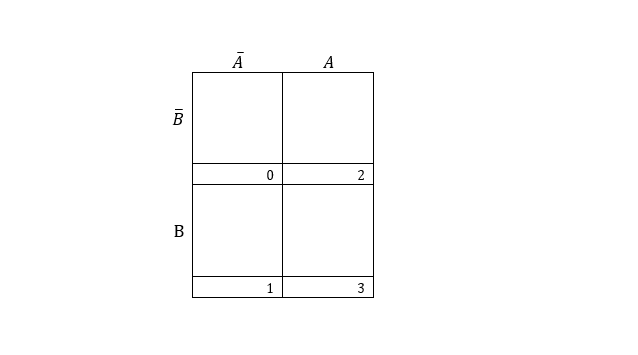
K-map for three entries is, (A,B,C)=23=8:

K-map for four entries is, (A,B,C,D)=24=16:

For each entry data is mapped, in the power of 2 itself. Maximum number of entries are grouped, in the powers of base 2 in decending order, i.e., …16,8,4,2. A single entry can never be considered.
Example 6: Considering entries, f=∑8,10,11,12,13,14,15, find the minimized expression using K-map.
K-map for the above entries is:
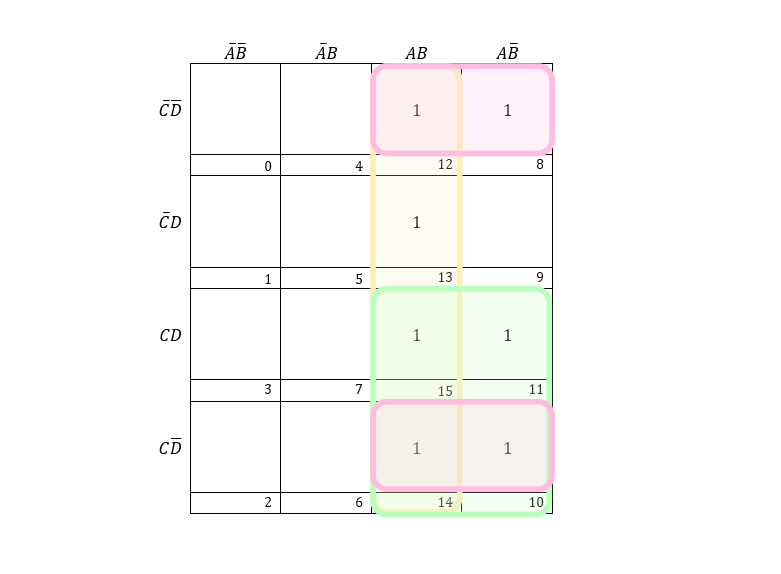
From the yellow region, the common variables are AB, the pink region has ADˉ in common, and the green region has AC in common. Therefore, the minimized result for the K-map is:
Result=AB+AC+ADˉ
Example 7: Considering entries, f=∑7,9,10,11,12,13,14,15, find the minimized expression using K-map.
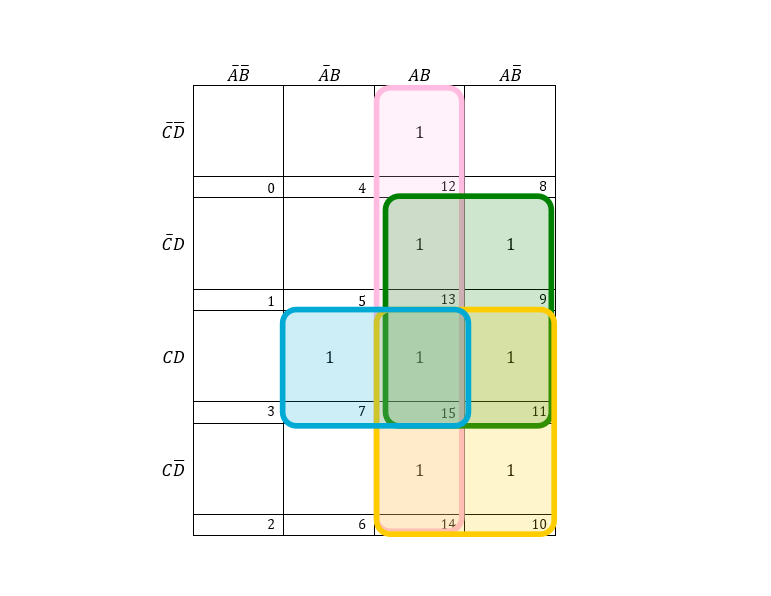
From, the pink region, we have AB, the green region has AD in common, the blue region has BCD in common, and the wellow region has AC in common.
∴Result=AB+AD+AC+BCD
Don't care condition, is when entries have no effect on the minimization but can be used to help pair other entries are called don't care entries.
Example 8: Considering entries, f(A,B,C,D)=m∑(1,3,7,11,15)+d∑(0,2,5), find the minimized expression using K-map.
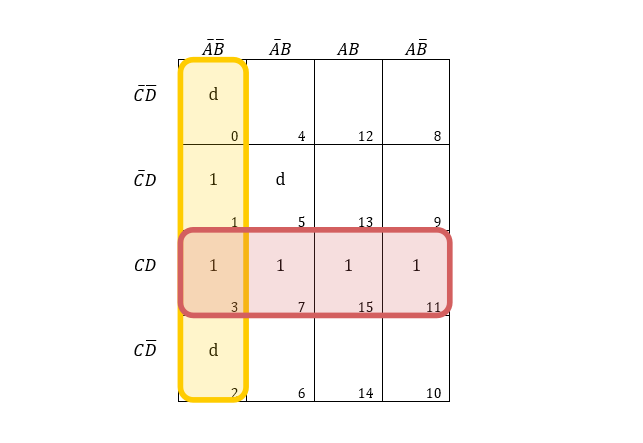
From the red region, we have CD as common, and from the yellow region, we have AˉBˉ as common.
∴Result=AˉBˉ+CD
Example 9: Considering entries, f(A,B,C,D)=m∑(0,2,3,6,7)+d∑(8,10,11,15), find the minimized expression using K-map.
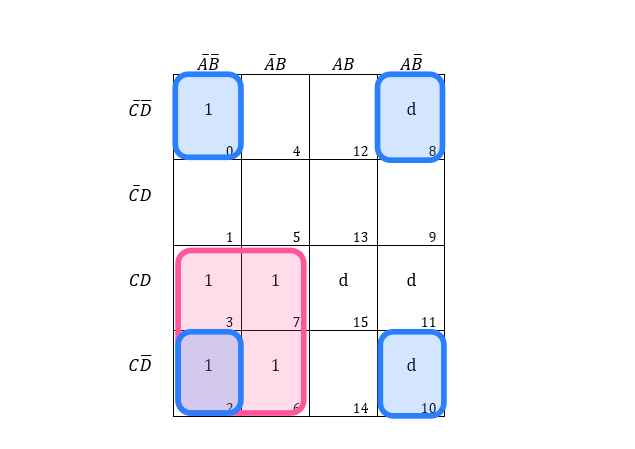
From the pink region, we have AˉC common, and from blue regions in the corners, we have BˉDˉ as common.
∴Result=AˉC+BˉDˉ
Product of sums
In sum of products, we consider the entries as 1 to perform operations, but in case of product of sums, we consider the entries as 0 to perform operations.
K-map for four entries in products of sum i.e, f(A,B,C,D) is:
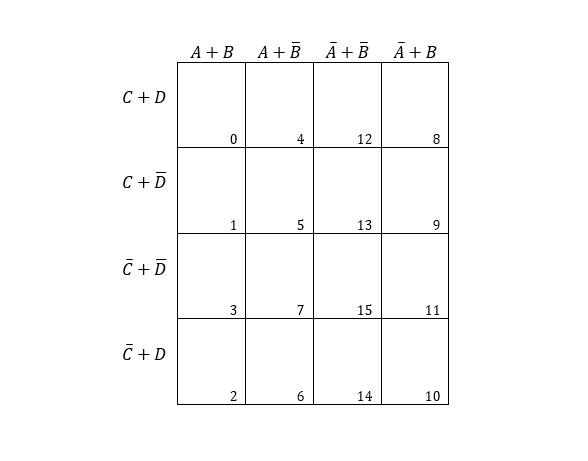
Example 10: Considering entries, f(A,B,C,D)=π(1,3,5,7,9,10,12,13), find the minimized expression using K-map.
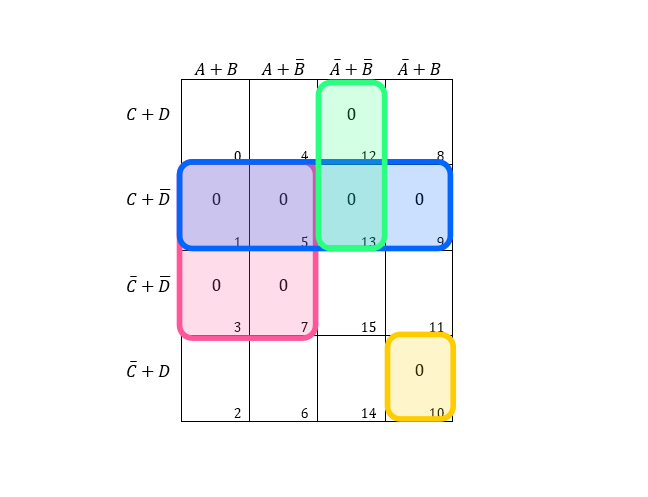
From the blue region, we can get the sum as C+Dˉ. From the red region we get the sum as, A+Dˉ, from the green region, we get, Aˉ+Bˉ+C, and from the yellow region, we have Aˉ+B+Cˉ+D.
∴Result=(Aˉ+Bˉ+C).(C+Dˉ).(A+Dˉ).(Aˉ+B+Cˉ+D)
Example 11: Considering entries, f(A,B,C,D)=πm(0,2,3,5,7,8,13)+πd(1,6,12), find the minimized expression using K-map.
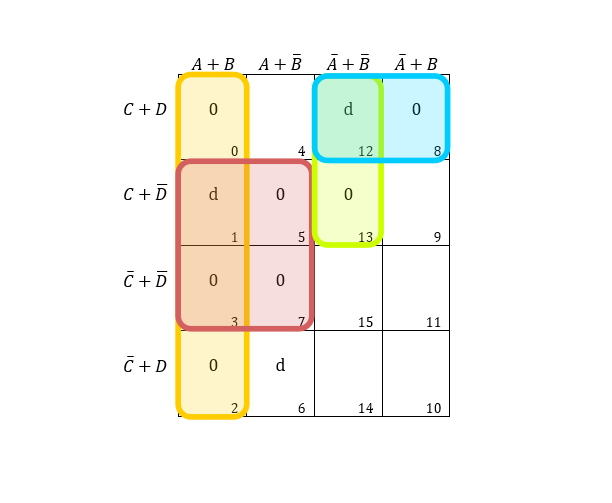
From the yellow region, we have A+B, the red region gives, A+Dˉ, the blue region gives, Aˉ+C+D, and the green region gives, Aˉ+Bˉ+C.
∴Result=(A+B)(A+Dˉ)(Aˉ+C+D)(Aˉ+Bˉ+C)
Example 12: A company has 100 shares. There are four shareholders written as f(x)=S, where x is the shareholder and S is the number of shares. The four shareholders and their shares are: f(A)=40, f(B)=30, f(C)=20, f(D)=10. Make a digital circuit such that the resolution will be passed if 2/3-rd of the vote is for it.
Solution:
Equivalent votes required to pass a resolution:
ve=32×100=66.67≈67
Truth table for votes and resolution passing:
| A | B | C | D | P | E |
|---|
| 0 | 0 | 0 | 0 | 0 | 0 |
| 0 | 0 | 0 | 1 | 0 | 1 |
| 0 | 0 | 1 | 0 | 0 | 2 |
| 0 | 0 | 1 | 1 | 0 | 3 |
| 0 | 1 | 0 | 0 | 0 | 4 |
| 0 | 1 | 0 | 1 | 0 | 5 |
| 0 | 1 | 1 | 0 | 0 | 6 |
| 0 | 1 | 1 | 1 | 0 | 7 |
| 1 | 0 | 0 | 0 | 0 | 8 |
| 1 | 0 | 0 | 1 | 0 | 9 |
| 1 | 0 | 1 | 0 | 0 | 10 |
| 1 | 0 | 1 | 1 | 1 | 11 |
| 1 | 1 | 0 | 0 | 1 | 12 |
| 1 | 1 | 0 | 1 | 1 | 13 |
| 1 | 1 | 1 | 0 | 1 | 14 |
| 1 | 1 | 1 | 1 | 1 | 15 |
where, P is the passing of resolution, and E is the equivalent digit
K-map for the circuit:
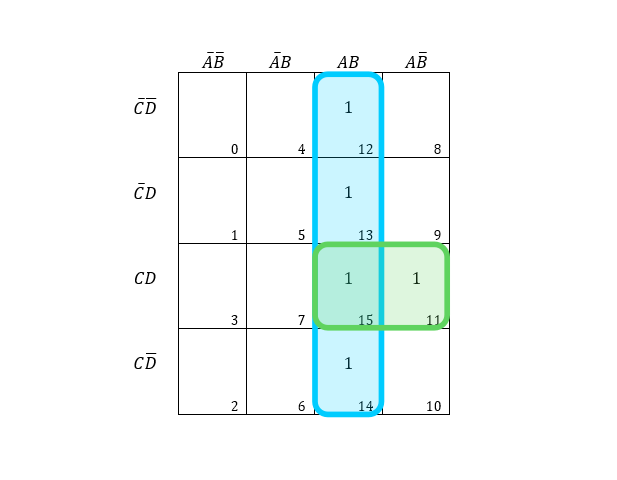
From the blue region, we have AB has common, and in the green region, we have ACD as common.
Therefore, the circuit result is:
Result=AB+ACD
De-Morgan's theorem
De-Morgan's theorem, has the following operations:
Example 13: Evaluate (Aˉ+BˉC).(AB+C)
Expression=(Aˉ+BˉC).(AB+C)=(Aˉ+BˉC)+(AB+C)=Aˉ.BˉC+AB.Cˉ=A.(B+Cˉ)+ABCˉ
Example 14: Evaluate (AB+Cˉ).(A+B+C)+AˉB
Expression=(AB+Cˉ).(A+B+C)+AˉB={(AB+Cˉ).(A+B+C)}.(AˉB)={(AB+Cˉ)+(A+B+C)}.(Aˉˉ+Bˉ)={(AB.Cˉˉ)+(A+B).Cˉ}.(A+Bˉ)={(Aˉ+Bˉ).C+(A+B).Cˉ}.(A+Bˉ)
Prove that: (A+B)(AˉCˉ+C)(Bˉ+AC)=AˉB
LHS=(A+B)(AˉCˉ+C)(Bˉ+AC)=(A+B)(Aˉ+C)(Bˉˉ.AC)=(A+B)(Aˉ+C){B(Aˉ+Cˉ)}=(AAˉ+AC+AˉB+BC)(Aˉ+Cˉ)B=(AC+AˉB+BC)(AˉB+BCˉ)=AˉABC+AˉB+AˉBC+ABCCˉ+AˉBCˉ+BCCˉ=AˉB+AˉB(C+Cˉ)=AˉB+AˉB=AˉB=RHS[∵XˉY+X=Y+X][∵Xˉ.X=0][∵X+Xˉ=1]









